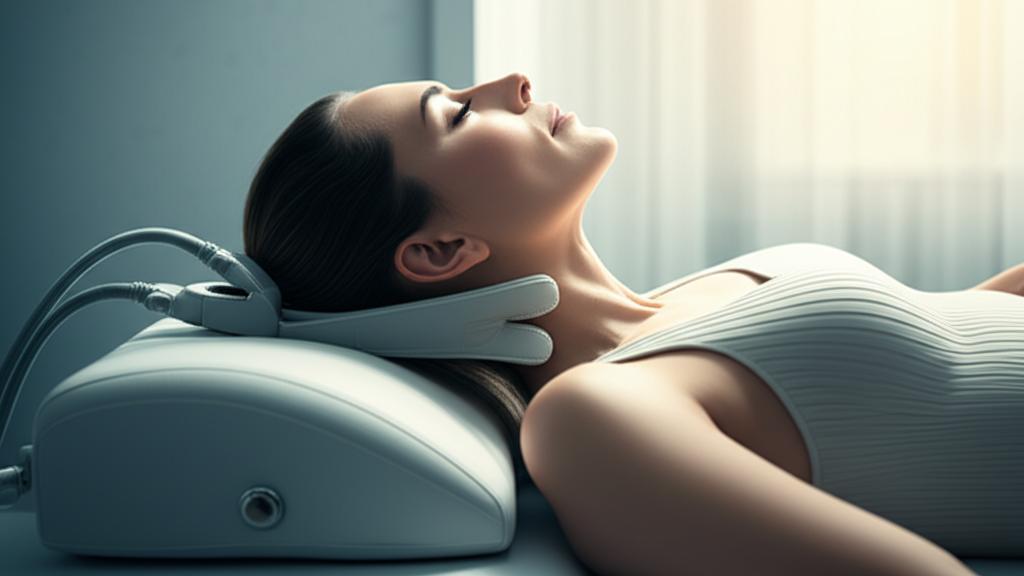I see it all the time in my clinic. Someone comes in, and they can barely turn their head. They describe a deep, nagging ache, a stiffness that just won’t quit, or maybe even tingling shooting down an arm. It’s that feeling of being trapped by pain in your own neck. For some of these folks, one of the tools we can turn to is a gentle, targeted treatment called cervical traction. It might sound a bit technical, but the idea behind it is beautifully simple: creating space to find relief.
Understanding Cervical Traction
So, what exactly is it? Cervical traction is a form of physical therapy where a light, steady pulling force is applied to your head to stretch your neck. The “cervical” part just refers to the top section of your spine—the seven small bones, or vertebrae, that make up your neck.
Think of your spine like a stack of doughnuts (the vertebrae) with jelly filling in between (the discs). Over time, or due to injury, that stack can get compressed. The jelly can bulge, and the doughnuts can get too close, pinching the delicate nerves that run through them. Cervical traction gently pulls that stack apart, giving everything more room to breathe. This can take pressure off the discs, nerves, and muscles, helping to ease pain.
How Is It Done?
There are two main ways we can DO this, and neither should be painful.
- Manual Cervical Traction: This is the hands-on approach. A physical therapist or doctor will gently hold your head and apply a slow, steady pull. We can adjust the angle and pressure in real-time based on how you’re feeling. It’s a very controlled process.
- Mechanical Cervical Traction: For this, we use a special device. You’ll typically lie down comfortably, and a harness or headrest is placed around your head. This is connected to a system that applies a very precise and consistent pulling force for a set amount of time.
Who Can Benefit from This Therapy?
This isn’t a cure-all, but it can be a fantastic tool for a range of issues causing neck pain. We often recommend it as part of a broader treatment plan that includes exercises and other therapies.
It can be helpful for:
- Pinched Nerves (Radiculopathy): When a nerve root leaving your spine gets squeezed, causing pain, weakness, or numbness.
- Degenerative Disc Disease: The natural wear and tear on your spinal discs that happens with age.
- Cervical Spondylosis: A general term for age-related changes in the neck bones and discs, basically arthritis of the neck.
- Neck Sprains and Strains: Muscle injuries that cause pain and stiffness.
- Spinal Stenosis: A narrowing of the spinal canal that can put pressure on the spinal cord and nerves.
The immediate goal is often simple: to reduce that sharp pain and ease the tension in your neck muscles. Many people feel a sense of relief right away.
Over time, this can lead to better flexibility and an improved range of motion—letting you turn your head to check your blind spot again without wincing.
Is Cervical Traction Always Safe?
While it’s a low-risk procedure, it isn’t right for everyone. Your safety is always the top priority, so we have to be sure your spine is stable and healthy enough for this kind of therapy. We’ll always do a thorough check, but it’s important to be upfront about your health history.
Below are some situations where we would likely avoid cervical traction.
| When Cervical Traction May Not Be Recommended | |
|---|---|
| Condition | Why It’s a Concern |
| Recent neck injury or fracture | The spine needs to be stable to heal properly; traction could interfere. |
| Osteoporosis or other bone-weakening conditions | The vertebrae might be too fragile to handle the pulling force. |
| Spinal cord tumors or infections (osteomyelitis) | Traction could worsen these serious underlying conditions. |
| Untreated high blood pressure (hypertension) | The procedure can sometimes cause temporary changes in blood pressure. |
| Pregnancy | Hormonal changes can cause ligament laxity, so we proceed with caution. |
It’s also worth knowing that while the relief can be significant, it might be temporary for some. Cervical traction is often a piece of a larger puzzle, not a standalone, permanent fix.
When to Pick Up the Phone
If you’re using an at-home device, it’s crucial to follow the instructions perfectly. And whether you’re getting treatment at a clinic or at home, stop and call your doctor if you experience anything new or concerning.
| Call Your Doctor if You Experience… |
|---|
| • Any new pain, or if your existing pain gets worse. |
| • New numbness or tingling in your arms, hands, or legs. |
| • Dizziness or changes in your vision. |
| • The onset of a headache you didn’t have before. |
Take-Home Message
- What it is: Cervical traction is a therapy that gently stretches your neck to relieve pressure on the spine and nerves.
- How it helps: It’s used to reduce pain and stiffness from conditions like pinched nerves, degenerative disc disease, and neck sprains.
- It’s not for everyone: We must rule out conditions like severe osteoporosis, spinal instability, or certain tumors before starting treatment.
- Listen to your body: The procedure should not be painful. If you feel any new pain, numbness, or dizziness, stop and tell your doctor right away.
- Part of a plan: Think of cervical traction as one effective tool in our toolbox, often best used alongside targeted exercises and other physical therapies.
Living with neck pain can be incredibly draining, but you don’t have to just push through it. There are options, and we can explore them together. You’re not alone in this.


